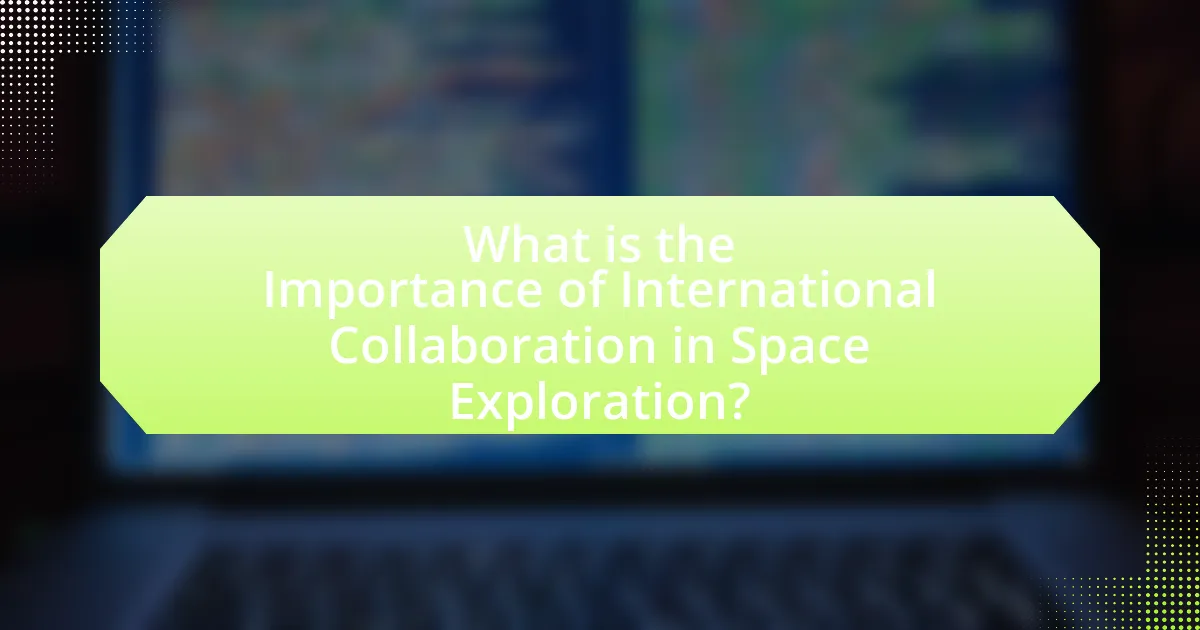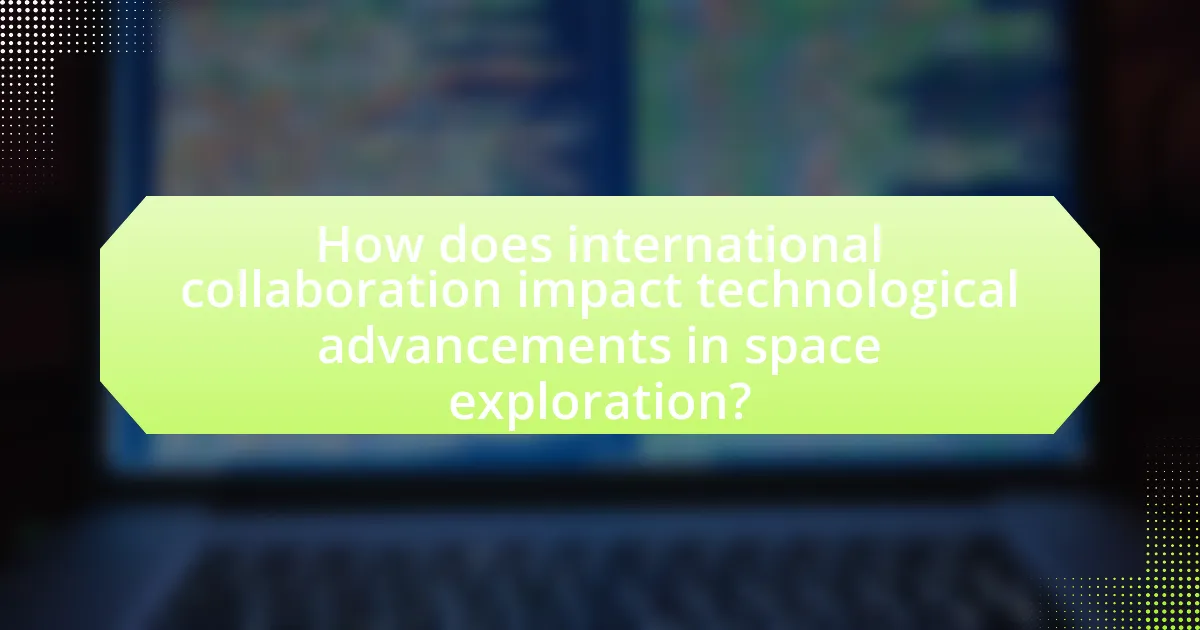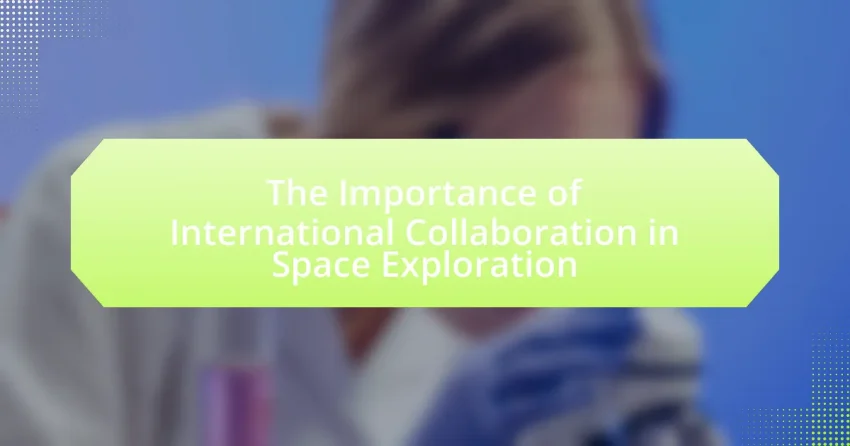The article focuses on the significance of international collaboration in space exploration, emphasizing how pooling resources, expertise, and technology from multiple countries enhances mission efficiency and effectiveness. It highlights historical examples, such as the Apollo-Soyuz Test Project and the International Space Station (ISS), which showcase the benefits of joint efforts in scientific research and technological advancements. The article also addresses the challenges faced in international partnerships, including differing national priorities and cultural differences, while discussing the political factors that influence collaboration. Furthermore, it explores the future prospects for cooperative missions and best practices for improving collaboration among nations in space exploration.

What is the Importance of International Collaboration in Space Exploration?
International collaboration in space exploration is crucial for pooling resources, expertise, and technology, which enhances the efficiency and effectiveness of missions. Collaborative efforts, such as the International Space Station (ISS), demonstrate how countries can work together to achieve common scientific goals, sharing costs and risks while fostering innovation. For instance, the ISS involves contributions from 15 nations, allowing for a diverse range of scientific research that would be difficult for any single country to undertake alone. This collaboration not only accelerates advancements in space science but also promotes peaceful international relations and inspires future generations in STEM fields.
Why is international collaboration essential for space exploration?
International collaboration is essential for space exploration because it combines resources, expertise, and technology from multiple countries, enhancing the overall capability to conduct complex missions. For instance, the International Space Station (ISS) is a prime example, involving contributions from 15 nations, which has enabled groundbreaking scientific research and technological advancements that no single nation could achieve alone. Additionally, collaborative efforts reduce costs and risks associated with space missions, as seen in joint projects like the Mars Rover missions, where shared knowledge and funding have led to successful exploration of the Martian surface.
What historical examples illustrate the benefits of international collaboration in space exploration?
The Apollo-Soyuz Test Project in 1972 exemplifies the benefits of international collaboration in space exploration. This mission marked the first international human spaceflight, where American astronauts and Soviet cosmonauts docked their spacecraft in orbit, demonstrating the potential for cooperation during the Cold War. The collaboration fostered mutual understanding and laid the groundwork for future partnerships, such as the International Space Station (ISS). The ISS, launched in 1998, involves contributions from multiple countries, including the United States, Russia, Europe, Japan, and Canada, showcasing how shared resources and expertise can enhance scientific research and technological advancements in space.
How does international collaboration enhance scientific research in space?
International collaboration enhances scientific research in space by pooling resources, expertise, and technology from multiple countries, leading to more comprehensive and innovative solutions. For instance, the International Space Station (ISS) is a prime example where collaboration among NASA, ESA, Roscosmos, JAXA, and CSA has resulted in significant advancements in microgravity research, benefiting fields such as medicine and materials science. This partnership allows for shared funding, which reduces individual financial burdens, and facilitates access to a wider array of scientific instruments and facilities, ultimately accelerating the pace of discovery and fostering a global scientific community.
What are the key challenges faced in international collaboration for space exploration?
The key challenges faced in international collaboration for space exploration include differing national priorities, regulatory and legal complexities, and cultural differences. National priorities can lead to conflicts in mission objectives, as countries may prioritize their own interests over collaborative goals. Regulatory and legal complexities arise from varying space laws and policies, which can hinder cooperation and create barriers to sharing technology and data. Cultural differences can affect communication and teamwork, making it difficult to establish a cohesive working environment among diverse international teams. These challenges have been observed in various collaborative projects, such as the International Space Station, where differing agendas and operational protocols have required extensive negotiation and compromise.
What political factors influence international collaboration in space exploration?
Political factors that influence international collaboration in space exploration include national security interests, diplomatic relations, and funding priorities. National security concerns often drive countries to collaborate on space missions to enhance their technological capabilities and share intelligence, as seen in partnerships like the International Space Station, which involves multiple nations working together for mutual benefits. Diplomatic relations play a crucial role, as countries with strong ties are more likely to engage in joint space initiatives; for example, the collaboration between the United States and European Space Agency is facilitated by their longstanding political alliance. Additionally, funding priorities set by governments can either promote or hinder international projects, as seen in the varying levels of investment in space programs by different nations, which directly impacts their ability to participate in collaborative efforts.
How do cultural differences impact collaborative efforts in space missions?
Cultural differences significantly impact collaborative efforts in space missions by influencing communication styles, decision-making processes, and team dynamics. For instance, teams from collectivist cultures may prioritize group consensus, while those from individualistic cultures might emphasize personal accountability and assertiveness. This divergence can lead to misunderstandings or conflicts during mission planning and execution. A study by the European Space Agency highlighted that effective cross-cultural training improved collaboration among international teams, demonstrating that awareness and adaptation to cultural differences enhance mission success.

How does international collaboration impact technological advancements in space exploration?
International collaboration significantly accelerates technological advancements in space exploration by pooling resources, expertise, and funding from multiple countries. For instance, the International Space Station (ISS) is a prime example, where contributions from NASA, Roscosmos, ESA, JAXA, and CSA have led to innovations in life support systems, robotics, and materials science. Collaborative projects like the Mars Rover missions have also benefited from shared knowledge and technology, resulting in more sophisticated instruments and enhanced data collection capabilities. This synergy not only reduces costs but also fosters a diverse range of perspectives, driving creativity and problem-solving in the development of new technologies essential for future exploration missions.
What technologies have emerged from international partnerships in space exploration?
International partnerships in space exploration have led to the development of advanced technologies such as the International Space Station (ISS), satellite communication systems, and Earth observation technologies. The ISS, a collaborative effort involving NASA, Roscosmos, ESA, JAXA, and CSA, serves as a microgravity research laboratory, enabling scientific advancements in various fields. Satellite communication systems, developed through partnerships like the European Space Agency’s Copernicus program, enhance global connectivity and data sharing. Additionally, Earth observation technologies, such as those from the Sentinel satellites, provide critical data for climate monitoring and disaster management, showcasing the tangible benefits of international collaboration in space exploration.
How do shared resources contribute to technological innovation in space missions?
Shared resources significantly enhance technological innovation in space missions by enabling collaborative development and reducing costs. When multiple space agencies or organizations pool their resources, they can leverage diverse expertise, technologies, and funding, which accelerates the research and development process. For instance, the International Space Station (ISS) exemplifies this collaboration, where contributions from NASA, ESA, Roscosmos, JAXA, and CSA have led to advancements in life support systems, robotics, and materials science. This shared approach not only fosters innovation but also allows for the rapid prototyping and testing of new technologies, as seen in the development of advanced spacecraft systems that benefit from the combined knowledge and experience of international partners.
What role do international space agencies play in developing new technologies?
International space agencies play a crucial role in developing new technologies by fostering collaboration and pooling resources for research and innovation. These agencies, such as NASA, ESA, and Roscosmos, engage in joint missions and projects that leverage diverse expertise and funding, leading to advancements in areas like satellite technology, propulsion systems, and life support systems. For instance, the International Space Station (ISS) serves as a platform for international cooperation, resulting in over 2,000 scientific experiments that have contributed to technology development in fields such as materials science and medicine. This collaborative approach accelerates technological progress and enhances the capabilities of individual agencies, ultimately benefiting global space exploration efforts.
How does international collaboration affect funding and resource allocation for space exploration?
International collaboration significantly enhances funding and resource allocation for space exploration by pooling financial and technological resources from multiple countries. This collaborative approach allows nations to share the high costs associated with space missions, as seen in projects like the International Space Station (ISS), which involves contributions from NASA, ESA, Roscosmos, JAXA, and CSA, collectively investing over $150 billion since its inception. Furthermore, international partnerships facilitate access to diverse expertise and technologies, optimizing resource utilization and enabling more ambitious missions that would be financially unfeasible for individual countries. For instance, the Mars Sample Return mission is a collaborative effort involving NASA and ESA, demonstrating how shared investment can lead to groundbreaking scientific advancements.
What are the financial benefits of pooling resources among countries for space projects?
Pooling resources among countries for space projects leads to significant financial benefits, including cost-sharing, risk reduction, and enhanced funding opportunities. By collaborating, nations can distribute the high costs of space missions, which can exceed billions of dollars, thereby making ambitious projects more financially feasible. For instance, the International Space Station (ISS) program, involving multiple countries, has allowed for shared operational costs and infrastructure investments, resulting in savings for individual nations. Additionally, joint missions can attract more funding from both governmental and private sectors, as seen in the European Space Agency’s partnerships that leverage contributions from member states to secure larger budgets. This collaborative approach not only maximizes financial efficiency but also fosters innovation through shared expertise and technology, ultimately leading to more successful and sustainable space exploration initiatives.
How do international agreements influence funding for collaborative space missions?
International agreements significantly influence funding for collaborative space missions by establishing frameworks for shared resources, responsibilities, and financial commitments among participating nations. These agreements, such as the Outer Space Treaty and various bilateral or multilateral partnerships, facilitate the pooling of financial resources, which can lead to increased investment in joint projects. For instance, the International Space Station (ISS) program, supported by agreements among space agencies like NASA, Roscosmos, and ESA, has seen contributions from multiple countries, resulting in a combined budget that exceeds $150 billion. This collaborative funding model not only enhances the capabilities of individual nations but also promotes technological advancements and scientific research through shared expertise and infrastructure.

What are the future prospects for international collaboration in space exploration?
The future prospects for international collaboration in space exploration are promising, driven by shared goals such as scientific discovery, resource utilization, and planetary defense. Collaborative projects like the International Space Station (ISS) have demonstrated the effectiveness of partnerships among space agencies, including NASA, ESA, Roscosmos, and JAXA, fostering advancements in technology and research. Furthermore, initiatives like the Artemis Accords encourage countries to work together on lunar exploration, emphasizing transparency and peaceful use of outer space. As nations face common challenges, such as climate change and the need for sustainable practices, the trend towards collaborative missions is expected to grow, enhancing global cooperation and innovation in space exploration.
How can countries improve their collaborative efforts in future space missions?
Countries can improve their collaborative efforts in future space missions by establishing formal agreements that outline shared goals, responsibilities, and resource allocations. Such agreements can facilitate joint missions, like the International Space Station, which has successfully brought together multiple nations to work towards common scientific objectives. Additionally, countries can enhance collaboration by investing in shared technologies and infrastructure, as demonstrated by the European Space Agency’s partnerships with NASA and other space agencies, which have led to significant advancements in satellite technology and deep space exploration. Regular international forums and workshops can also foster communication and innovation, allowing nations to share best practices and lessons learned from past missions.
What initiatives are currently being proposed to enhance international cooperation in space exploration?
Current initiatives proposed to enhance international cooperation in space exploration include the Artemis Accords, which aim to establish a framework for sustainable lunar exploration and promote peaceful cooperation among nations. Additionally, the International Space Station (ISS) partnership continues to serve as a model for collaborative research and technology development in low Earth orbit, involving multiple countries such as the United States, Russia, Europe, Japan, and Canada. Furthermore, the Global Space Exploration Conference (GLEX) facilitates dialogue among space agencies and stakeholders to align goals and share best practices, fostering a collaborative approach to future missions. These initiatives are supported by the increasing recognition of the need for shared resources and knowledge to address complex challenges in space exploration.
How can emerging space nations contribute to international collaboration in space exploration?
Emerging space nations can contribute to international collaboration in space exploration by providing unique resources, diverse perspectives, and innovative technologies. These nations often possess specific geographical advantages, such as access to different orbital paths or natural resources, which can enhance collaborative missions. For instance, countries like India and the United Arab Emirates have successfully launched missions that contribute to global scientific knowledge, such as India’s Mars Orbiter Mission, which demonstrated cost-effective space technology. Additionally, emerging space nations can foster partnerships through joint missions, sharing data, and participating in international space treaties, thereby promoting a cooperative approach to addressing challenges like space debris and planetary defense. This collaborative framework not only accelerates technological advancements but also strengthens diplomatic ties among nations, as evidenced by initiatives like the International Space Station, which includes contributions from multiple countries, including those with emerging space programs.
What best practices can be adopted for successful international collaboration in space exploration?
Successful international collaboration in space exploration can be achieved by establishing clear communication channels among all stakeholders. Effective communication fosters mutual understanding and aligns objectives, as demonstrated by the International Space Station (ISS) program, where multiple countries coordinate efforts to conduct scientific research and share data. Additionally, creating standardized protocols for data sharing and project management enhances collaboration efficiency, as seen in the European Space Agency’s collaborative missions. Regular joint training exercises and workshops can also build trust and improve teamwork, evidenced by NASA’s partnerships with international space agencies for astronaut training. Finally, securing equitable funding and resource allocation ensures that all partners contribute fairly, which is crucial for long-term collaboration sustainability.
How can effective communication strategies improve collaboration among international teams?
Effective communication strategies enhance collaboration among international teams by fostering clarity, reducing misunderstandings, and building trust. When team members from diverse cultural backgrounds utilize structured communication methods, such as regular updates, clear guidelines, and collaborative tools, they can align their goals and expectations more effectively. Research indicates that organizations with strong communication practices experience a 25% increase in productivity, which is crucial in high-stakes environments like space exploration. Furthermore, effective communication helps in navigating language barriers and cultural differences, ensuring that all team members feel valued and understood, ultimately leading to more successful collaborative outcomes.
What lessons can be learned from past international space missions to enhance future collaborations?
Past international space missions demonstrate that effective communication and shared goals are crucial for successful collaboration. For instance, the International Space Station (ISS) program, involving multiple countries, highlights the importance of establishing clear communication channels and aligning objectives among diverse teams. This collaboration has resulted in significant scientific advancements, such as the development of new technologies and research in microgravity, which would not have been possible without the combined efforts of various nations. Furthermore, lessons from the Apollo-Soyuz Test Project in 1972 illustrate the value of mutual respect and understanding of different cultural approaches to problem-solving, fostering a cooperative environment that enhances mission success. These historical examples underscore the necessity of building trust and maintaining open dialogue to facilitate future international partnerships in space exploration.
